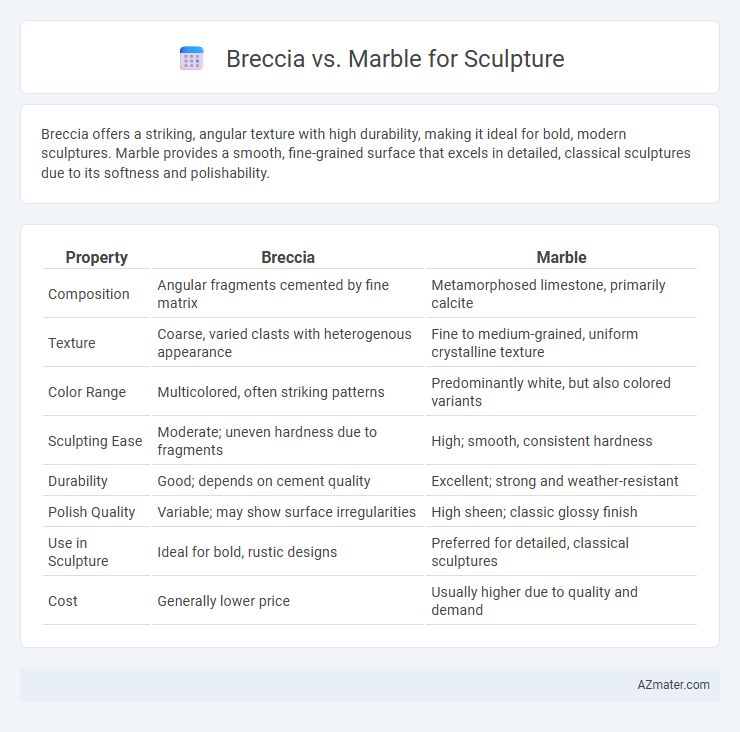Breccia offers a striking, angular texture with high durability, making it ideal for bold, modern sculptures. Marble provides a smooth, fine-grained surface that excels in detailed, classical sculptures due to its softness and polishability.
Table of Comparison
| Property | Breccia | Marble |
|---|---|---|
| Composition | Angular fragments cemented by fine matrix | Metamorphosed limestone, primarily calcite |
| Texture | Coarse, varied clasts with heterogenous appearance | Fine to medium-grained, uniform crystalline texture |
| Color Range | Multicolored, often striking patterns | Predominantly white, but also colored variants |
| Sculpting Ease | Moderate; uneven hardness due to fragments | High; smooth, consistent hardness |
| Durability | Good; depends on cement quality | Excellent; strong and weather-resistant |
| Polish Quality | Variable; may show surface irregularities | High sheen; classic glossy finish |
| Use in Sculpture | Ideal for bold, rustic designs | Preferred for detailed, classical sculptures |
| Cost | Generally lower price | Usually higher due to quality and demand |
Introduction: Breccia vs Marble in Sculpture
Breccia and marble are both prized materials in sculpture, each offering distinct aesthetic and structural qualities. Breccia features angular fragments cemented together, providing a dynamic, textured appearance that enhances natural patterns. Marble is valued for its smooth, consistent grain and ability to achieve fine detail and polished finishes, making it a timeless choice for classical and contemporary sculptures.
Geological Formation and Composition
Breccia, formed from angular rock fragments cemented by a fine matrix, boasts a heterogeneous composition that provides dynamic textures ideal for bold sculptural statements. Marble, a metamorphic rock primarily composed of recrystallized calcite, offers a uniform crystalline structure renowned for its smooth finish and fine detail in classical sculpture. The geological formation of breccia involves mechanical weathering and sedimentation, while marble originates from the metamorphism of limestone under intense heat and pressure.
Physical Characteristics of Breccia
Breccia features a coarse, angular clastic texture composed of broken fragments cemented together, offering high compressive strength and resistance to weathering, making it suitable for detailed sculpture work. Its varied mineral composition often results in striking color contrasts and complex patterns, enhancing aesthetic appeal in sculptural pieces. Breccia tends to be less homogeneous than marble, requiring careful selection for carving to avoid structural weaknesses.
Physical Characteristics of Marble
Marble is a metamorphic rock composed primarily of recrystallized carbonate minerals such as calcite or dolomite, known for its fine grain and uniform texture that allows for detailed carving. Its relatively soft hardness, typically around 3-5 on the Mohs scale, makes it easier for sculptors to shape intricate forms compared to harder stones like breccia. Marble's characteristic translucence adds a lifelike quality to sculptures, enhancing depth and detail in the final artwork.
Workability and Sculpting Techniques
Breccia offers moderate workability with its coarse, angular fragments requiring careful chisel control for detailed sculpting, while marble provides superior ease due to its fine-grained, homogenous texture allowing precision carving and smooth finishes. Sculptors favor marble for intricate techniques such as point chisel and rasps, whereas breccia demands adapting to its natural fractures by using heavier tools like claw chisels to respect the stone's unique pattern. Mastery in breccia sculpting involves emphasizing its color and texture contrasts, while marble's versatility supports both classical and contemporary artistic expressions.
Aesthetic Qualities and Visual Appeal
Breccia features a dynamic, fragmented appearance with angular, multicolored fragments that create striking patterns, making it highly distinctive for sculptures requiring bold visual impact. Marble offers a smooth, uniform texture with subtle veining, often prized for its classic elegance and ability to capture fine detail in sculptural work. The choice between breccia and marble depends on desired artistic expression, with breccia emphasizing rugged texture and vibrant contrast, while marble emphasizes refined beauty and translucency.
Durability and Longevity in Artworks
Breccia and marble differ significantly in durability and longevity for sculptures, with marble exhibiting superior resistance to weathering and erosion due to its dense crystalline structure and homogenous composition. Breccia, composed of angular fragments cemented together, tends to be more porous and susceptible to fracture and degradation under environmental stress, making it less ideal for outdoor or long-term installations. Artists seeking longevity in sculptures often prefer marble for its ability to maintain fine details and structural integrity over centuries.
Historical Use in Sculpture
Breccia and marble have both played significant roles in historical sculpture, with marble renowned since ancient Greece and Rome for its fine grain and translucency, allowing detailed, lifelike carvings in masterpieces like Michelangelo's David. Breccia, characterized by its coarse texture and multicolored fragments cemented together, was favored in Roman and Renaissance sculptures for decorative elements and architectural features due to its striking visual contrast and durability. The choice between breccia and marble historically depended on the desired aesthetic effect and structural requirements, with marble preferred for figurative work and breccia for ornamental or monumental purposes.
Cost and Availability for Artists
Breccia offers a unique aesthetic with its angular fragments, often available at a lower cost compared to Marble, making it an economical choice for emerging sculptors. Marble, particularly Carrara Marble, is prized for its fine grain and durability but comes with higher prices and limited quarry sources, impacting accessibility for artists. Availability of Breccia varies regionally, while Marble has a more established supply chain, influencing both material selection and project budgeting in sculpture.
Conclusion: Choosing Between Breccia and Marble
Choosing between Breccia and Marble for sculpture depends on the desired aesthetic and durability. Breccia offers a unique, fragmented texture with vibrant color variations ideal for bold, modern designs, while Marble provides a classic, smooth finish favored for detailed, timeless sculptures. Sculptors should consider the specific project requirements and environmental conditions to select the optimal stone for longevity and visual impact.

Infographic: Breccia vs Marble for Sculpture
 azmater.com
azmater.com